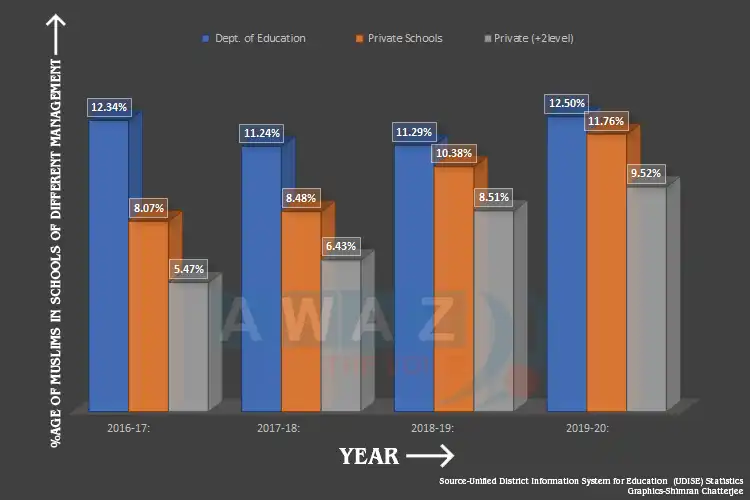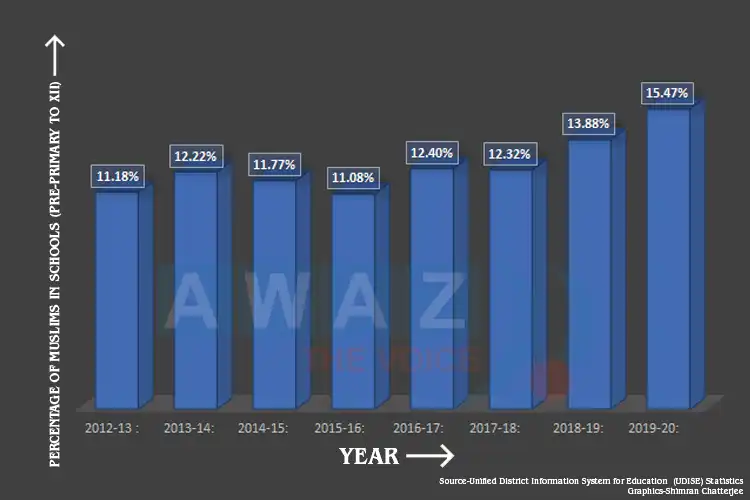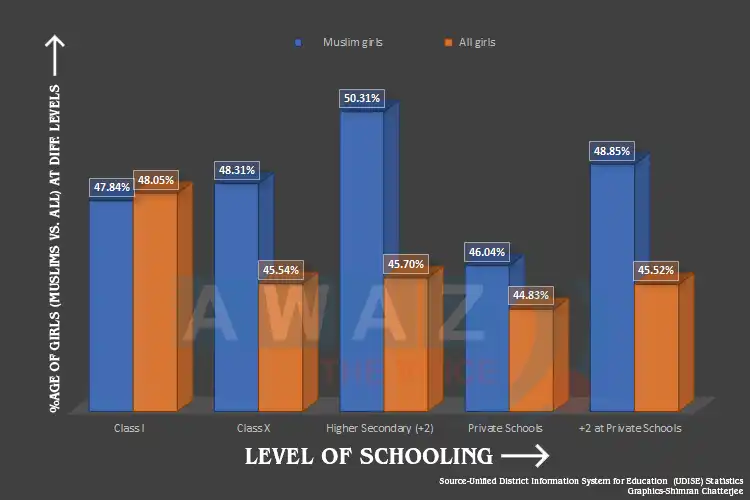 Saquib Salim
Saquib Salim
Indian Muslims as a community, due to various social and political influences, have remained educationally backward. The Sachar Committee Report in 2006 revealed the dismal state of education among Muslims. The report was an eye-opener for the community and led to the efforts to spread education among Muslims. Muslims introspected and asked how come a community that believes in “Read with the name of your Lord who created (everything)” - the first Quranic revelation - lagged in education. Not only did the community urge the country's political leadership to address it but also made efforts to improve the state of affairs.
The efforts have not gone in vain. The data compiled in the Unified District Information System for Education (UDISE) by the Union Ministry of Education, points towards a remarkable increase in school-going Muslims in Uttar Pradesh, the most populous state in India.
Changing trends among Muslims
The UDISE survey reveals that in U.P, 4,53,62,059 students were studying in schools, from pre-nursery to class XII, during the 2019-20 session. Out of these, 70,18,201, or 15.47%, were Muslims. Because the Muslims are 19.26% of the population in the state, this number seems insufficient, which it is. But, if we consider the fact that seven years ago, in the 2012-13 session, out of 4,69,61,179 school-going children only 52,49,664, or 11.18%, were Muslims, the significance of the present numbers becomes evident.
The numbers show that the proportion of Muslims is steadily increasing and moving towards their proportion in the population, i.e. 19.26%. From the 2015-16 session till 2019-20, the percentage of Muslims among school-going children has been registered to be 11.08%, 12.40%, 12.32%, 13.88%, and 15.47% in successive years. If we talk in pure numbers, in 2015-16, there were 53,63,670 Muslim kids out of 4,84,06,853 students. In 2019-20, this figure has increased by more than 16 lakh to reach 70,18,201 as the total school enrolment in the state dropped by more than 30 lakhs.
Graphic explanation of the changing trend in Muslim education-1
In order to understand the recent awakening in the community, one needs to look at the new enrollments. At the entry-level, Muslim students have reached very near to their proportion in the population. In the 2019-20 session, out of 51,48,352 students enrolled in class I, 9,71,229 were Muslims. This translates into 18.86% of the total class I students. It is a significant increase from 2018-19 when 16.92% of class I students were found to be Muslims, and in the year before the ratio was at 16.23%.
The people working in the education sector among the Muslims of U.P often complain about the high dropout rates. As we go up the education levels, the proportion of Muslims tends to decrease. The apprehension is true, but the recent trends show an improvement in Muslim representation in higher classes. The survey found 3,73,304 Muslim students out of a total of 30,73,228 studying in class X, during the 2019-20 session. This makes 12.15% of the total class X students in the state, a significant rise from 2016-17 when only 7.65% of the total class X students were from the community. In the last four academic sessions, the proportion of Muslims in class X is, 7.65%, 8.38%, 10.90%, and 12.15%, successively.
At Higher Secondary (+2), XI & XII, the proportion of Muslims enrolled has increased from 7.24% in the 2016-17 to 10.48% in the 2019-20 session. In successive sessions this proportion has been registered as 7.24% in 2016-17, 7.81% in 2017-18, 10.08% in 2018-19 and 10.48% in 2019-20.
These numbers are no yardstick of the quality of education Muslims are availing. To get an idea we need to look at the type of schools at which these students are enrolled. As a matter of fact, in U.P, it is commonly believed that private schools are in a better condition than schools owned by the Department of Education. Out of the total 2,20,69,303 students enrolled in private schools, 25,95,073, or 11.76%, were found to be Muslims in 2019-20. This was a considerable increase from 2016-17 when 8.07% of the private school students were Muslims. In the last four academic sessions since 2016-17, the Muslim proportion in private schools was found to be 8.07%, 8.48%, 10.38%, and 11.76% respectively.
Changing trends in Muslims' education Graph-II
On the other hand, in the schools of the Department of Education, Muslim proportion remained more or less constant. In 2016-17, 12.34% of the students at the Department’s schools were Muslims which has shown a marginal increase at 12.50% in 2019-20. Another very important aspect of education among Muslims is that almost one out of every five school-going Muslims attends a Wakf/ Madrasa Board recognized Madrasa/ Maktab. In the 2019-20 session, 19.76% of the Muslim children were enrolled in these Madrasas. It is an increase from 2016-17 when 16.49% of Muslims were attending these institutions. But this shift can be attributed to a positive shift. In 2016-17, 5.31% of Muslim kids were attending unrecognized Madrasas which came down to 3.10% in 2019-20. It is a welcome change that Madrasa-going children are attending recognized Madrasa of Madrasa / Wakf Board instead of unrecognized Madrasas.
Prof. Aquil Ahmed (Statistics & OR), AMU, believes that an increase in enrolments in private schools and status quo in Department of Education’s schools is a pointer that this increase in education among Muslims owes itself to the efforts from within. In recent years, he says that the community has started understanding the importance of education and hence without much help from the government people have started spending on education more and sending their children to schools.
Bhim Rao Ambedkar said that women's education and empowerment were the yardstick to measure the development of a society. The survey gives us immense hope as we analyze the data on girl students among Muslims. It is an open secret that ours is a patriarchal society. Irrespective of religion or caste, people discriminate against girls. It was not a surprise to see that, in 2019-20, out of 45,39,933 students enrolled in Higher Secondary (+2) in the state, 54.30% were boys and 45.70% were girls. Similarly, in class X, 54.46% of the total students were boys. On a similar pattern, for the same session, 55.17% of students enrolled in private schools were boys during the same session. But, the sweet surprise was the ratio of girls among Muslim students of U.P. In Higher Secondary,
Changing trends in Muslims' education Graph-III
In 2019-20, 50.31% of the total Muslim students were girls while their proportion was 48.31% in class X. In private schools also enrolment of boys among Muslims was 53.96%. This means, among Muslims, proportionally more girls are being admitted in private schools than the average of the state. This positive approach towards women's education is a welcome trend.
The survey suggests that Muslims as a community are paying more attention to women's education. As discussed above, in 2019-20, 10.48% of the total enrolments in Higher Secondary (+2) belonged to the Muslim community. If we look at gender then we find that, in 2019-20, of all the girls enrolled in +2, 12.06% were Muslims while 9.67% of the boys came from the community. This trend is a feature of all the preceding years as well. In 2019-20, in private schools out of all the girls enrolled 12.08% were Muslims while the proportion among boys was 11.50%.
Interestingly, in higher secondary education in private schools, the proportion of Muslims among girls stands at 10.22% while among boys it is 8.94%. In each session we find more Muslim girls taking admissions in higher secondary than Muslim boys. The proportion of Muslims among girls is much higher than their proportion among boys. For class X, in 2019-20, 12.88% of girls were Muslims while among boys they were 11.53%. The trend breaks the stereotype that Muslims do not send their girls to school. Moreover, it shows that Muslims are moving away from the orthodox traditions faster than the other communities.
Prof. Nazura Usmani (AMU), believes that access of younger generations to religious texts has made this women empowerment possible. Muslims, on understanding the true message of religion, are breaking the shackles of traditional orthodoxies, which kept women caged for centuries. Now, people are understanding that women's education is part of religion and also there is growing acceptance in the community towards economically working women. She says that those people who do not identify themselves with revolutionary feminism are accepting that women should be educated and economically independent.
The UDISE survey report brings out a positive trend of increasing education among Muslims. Though the community is still lagging the developments of recent years instills hope. Moreover, the survey brings out that Muslims are showing more gender parity when it comes to education than other communities.
(Saquib Salim is a Historian and a Writer)
.jpg)
 Saquib Salim
Saquib Salim


